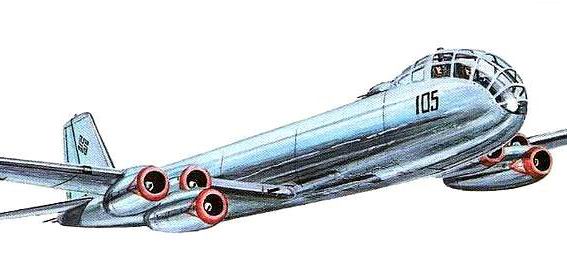EF-140 – Russian built EF-131 with 2 RR Nene (flown in 1948)
From late 1944 the Red Army overran many sites where German aircraft engineers had been working on jet aircraft and engines. The largest group had been in the employ of the vast Junkers Flugzeug und Motorenwerke in the Dessau area and at Brandis near Leipzig. At Brandis the principal project had been the Ju 287 jet bomber. Having flown the Ju 287 VI (a primitive proof-of-concept vehicle incorporating parts of other aircraft) on 16th August 1944, work had gone ahead rapidly on the definitive Ju 287 V2, to be powered by two triple engine pods, but the Soviet forces overran Brandis airfield before this could fly. This work was clearly of intense interest, and with the aid of a large team of ex-Junkers engineers, who were prisoners, the programme was continued with all possible speed. The Ju 287 V2 stage was skipped, and parts of this aircraft were used to speed the construction of the next-generation EF 131 (Entwicklungs Flugzeug, meaning research aircraft). This was built at Dessau, dismantled, and, together with many of the German engineers and test pilots, taken by train to Moscow. As explained in the next entry, they formed OKB-1. Final assembly took place at the test airfield then called Stakhanovo (today at LII Zhukovskii) where on or about 23rd May 1947 it was briefly flight tested by Flugkapitan Paul Julge. According to legend, he was never allowed enough fuel to reach ‘the West’. By this time more advanced aircraft and engines were being developed in the Soviet Union, and the EF 131 spent long periods on the ground. MAP Directive 207ss of 15th April 1947 had demanded that ‘two prototype EF- 131 with six RD-10 engines to take part in the August Tushino display…’ but this was impossible to achieve. Eventually the first aircraft was again made airworthy and flown to Moscow’s other experimental airfield, Tyopliy Stan. On 21st June 1948 the order was given to stop EF 131 work. This was because it had been overtaken by the much better Type 140.
The EF 131 was an impressive-looking jet bomber, characterised by its swept-forward wing. To postpone the rapid increase in drag as Mach number exceeds about 0.75 German aerodynamicists had from 1935 studied wings swept either backwards or forwards. The FSW (forward-swept wing) appeared to offer important aeroelastic advantages, but because such wings diverge under increasing aerodynamic load they are structurally very difficult. The Ju 287 VI avoided this problem by being a slow-speed aircraft, but the problem was met head-on by the 131 and 140, and also by the Tsybin LL-3. The first structurally satisfactory FSW was that of the Grumman X-29, almost 40 years later, and a more advanced FSW is seen in today’s Sukhoi S-37. Thus, the FSW of the EF 131 can be seen to have been an enormous challenge. Aerodynamically it was directly derived from that of the wartime Ju 287, with considerable dihedral and a leading edge swept forward at 19° 50′. It was fitted with slats at the wing roots, slotted flaps and outboard ailerons. It was also fitted with multiple spoiler/airbrakes and a total of eight shallow fences. Because of the limited (900kg, 1,9841b) thrust of the Junkers Jumo 004B engines these were arranged in groups of three on each underwing pylon. By late 1947 this engine was in limited production at Kazan as the RD-10, and because they were considered superior to the German originals the engines actually installed were RD-10s. The crew numbered three, and to save weight armour was omitted. A neat tricycle landing gear was fitted, the main tanks occupied the top of the fuselage, a braking parachute occupied a box under the tail, and at the end of the fuselage was a remotely sighted FA15 barbette with superimposed MG 131 guns as fitted to some wartime aircraft such as the Ju 388.
The FSW and primitive engines made this an unattractive aircraft.
Specifications (EF-131)
General characteristics
Crew: 3
Length: 20.47 m (67 ft 2 in)
Wingspan: 19.4 m (63 ft 7-3/4 in)
Height: 5.7 m (18 ft 8-1/2 in)
Empty weight: 11,900 kg (26,235 lb)
Gross weight: 22,955 kg (50,620 lb)
Powerplant: 6 × Junkers Motoren Jumo 109-004 turbojets, 8.829 kN (1,984 lbf) thrust each
Performance
Maximum speed: 860 km/h (534 mph)
Range: 1,710 km (1,063 miles)
Service ceiling: 12,500 m (41,000 ft)
Armament
2 x 13mm machine-guns in a remotely controlled tail barbette
2,000kg (4,410 lb) of bombs in an internal bomb bay.
